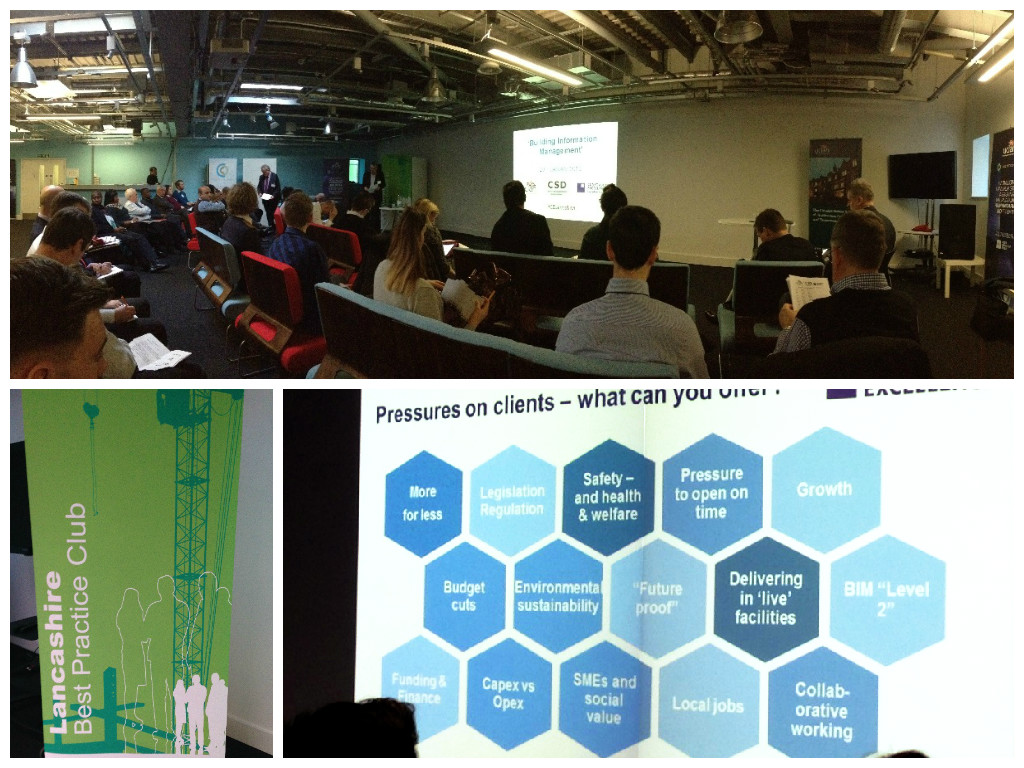Desire to “do BIM” is strong, but many companies still need support, this & other thoughts from #CELancsBIM

Tuesday afternoon saw over 40 construction professionals brave the cold and snow to come to the Media Centre at the University of Central Lancashire (UCLAN); well everyone except Mark Stogell @stodgeblog but more of that later…
The event was opened by the CE Lancs Club chair Martin Brown @fairsnape before handing over to Professor Jack Goulding of UCLAN, our chair for the afternoon.
But before the keynote speeches and round table sessions the first activity was a BIM poll. Everyone was equipped with voting buttons and took part in an interactive vote responding to BIM related questions on the screen. Honest answers flowed with 41% not yet ready for BIM; 21% think they are ready while 38% are ready. More honesty came with 59% accepting that they would not be able to deliver BIM if asked to on a project tomorrow and around 50% being unsure on the BIM capabilities of either their supply chain or partners. Almost 49% of the attendees were looking for BIM support, which I guess is why many were there. See results of poll below,
With that final voting result still sinking in it seemed very appropriate that Don Ward, Chief Executive of Constructing Excellence, should open with the first keynote, Collaborative Working Today. Don outlined the progress that has been made in the construction industry to get better at collaboration and the key role that Constructing Excellence has played in this process.
Highlights from Don were the massive health and safety improvements made by the industry (with still a way to go to zero) the economic multiplier benefits that construction brings as well as challenging clients to get better at delivering benefits to communities through their schemes.
After Don we were treated to a no-slides-and-very-few-notes presentation from John Lorimer. Apart from being very well known in the North West, John also chairs the CE BIM Steering Group, which meets before our thinkBIM conferences in Leeds. John gave his usual realistic views including reminding the audience that it’s still not possible to ‘do’ Level 2 BIM – the processes still aren’t complete.
John also reminded delegates that whilst the UK is currently seen to be leading the world in delivering BIM we mustn’t sit back as the rest of Europe is looking to capitalise on our foundations.
Our third keynote came from Malcolm Clarke, MD at Baxall Construction in Kent.
Malcolm gave the delegates an honest explanation of his business’s journey into BIM and how it is benefited the projects that Baxall deliver. Many great points from Malcolm – here are few
- Lonely / selfish BIM is a great way to start
- Baxall see BIM as edge for them with lots of customer satisfaction, the benefits of ‘no hassle’ collaboration
- BIM is a process not tool
- Build up your capabilities; Baxall have considerable experience with Union Square Workspace so understood how collaborative workflows were expected to work. This has been developed with the sue of model federating tools and most recently the purchase of 5D (cost) software
- A two year training plan to develop and embed digital workflow skills into the business
In a slight change to the programme we then had a quick pitch from Alison Watson, the driving force behind Class of your Own. Why so quick? Alison had been given the change to talk to a much larger group of local school children so we were politely dumped!! But we were left with no illusion that we all needed to Adopt a School, after all if we don’t then how do we expect students to want to come into our industry. If you still haven’t read about all her amazing work check it out here http://designengineerconstruct.com/
For much of the rest of the afternoon we broke up into 5 groups to participate in 2 roundtable sessions. The round table sessions were as follows
- Collaborative BIM; led by Don Ward
- Client Led BIM led; by John Lorimer
- Contractor Led BIM; Malcolm Clarke
- Our experience of BIM so far; Andrew Burningham, Severn Architecture
- BIM Guidance and Standards update; led by Mark Stogell, BIM Academy – well once he had come back from Rhyl, it would appear he got on the wrong train at some point!!
I chose Don and Malcolm’s sessions. Each group had a good cross section from industry including academia and FM businesses which was great to see. It was great to see so much knowledge and experience shared in these sessions, as should be case at any BIM event. Particular highlights of this were –
- Where to go to understand BIM acronyms; Rob Jackson, @bondbryanBIM , Bond Bryan Architects has a great BIM blog with both a dictionary and document list http://bimblog.bondbryan.com/
- Before embarking on your BIM journey first determine what are the business benefits you need or want to get from BIM
- BIM will help the design practices actually make money again!
- If you have good and long term relationships with your supply chain already you are well on the way to working better. Then look at ways to use BIM to enhance this further
- If you are breaking down the old construction silos don’t just throw the information together
At the end of these speakers each of the round table chairs were invited to the front to summarise the key points from their group discussions. Here are their points
Don Ward
- BIM already facilitating informal collaboration, up and down the chain, and improving communication
- Selfish BIM – work out what are your benefits
- There are lots of free resources out there
thinkBIM, @thinkBIM, http://ckegroup.org/thinkbimblog/
BIM Task Group, @BIMgcs, http://www.bimtaskgroup.org/
Constructing Excellence, @constructingexc, http://www.constructingexcellence.org.uk/
Bond Bryan BIM blog @bondbryanBIM, http://bimblog.bondbryan.com/
John Lorimer
- Is the client really interested in BIM? There needs to be leadership from the top
- If Clients are asking, industry needs to help the client
- Is age a barrier? No, but a big influence
Malcolm Clarke
- BIM doesn’t have to be client driven. Do it before they ask it, ‘selfish BIM’ is a good place to start
- There is a cost of start-up and training. Before you take the plunge, look hard at the actual savings
- BIM for FM – it’s a no brainer, why wouldn’t you
Andrew Burningham
- We’ve all been doing anyway, even in a basic way. Think of it as CAD with structural info added plus MEP.
- Getting past the jargon isn’t that big a step.
- Selfish BIM or lonely BIM a better term. Take the step to use it, don’t wait
Mark Stogell
- BIM-boozlement of acronyms and numbers is an issue
- If asked for level 2 then get a good understanding you what you have signed up to.
- Standards aren’t all done yet, keep an eye out on toolkit
- Some standards can be addressed as they are already in place.
- Do you actually understand BS1192:2007? Design manager bread and butter! Get it here http://shop.bsigroup.com/ProductDetail/?pid=000000000030163398
The afternoon was completed with a couple of Pecha Kucha’s from Martin Brown and myself before a few words from John Bridge, BIM Manager at Croft Goode.
Croft Goode are looking to develop their links with offsite manufacturers with a view to improving their design processes to better suit Design for Manufacture and Assembly, DFMA.
Get in touch with John via their website contact details
Many thanks to Martin Brown, the spekaers and the team at UCLAN for organising another great Constructing Excellence event. The next North West event is
Collaboration and Soft Landings – what’s it all about?
Constructing Excellence Manchester Best Practice Club, Wednesday 11th February 2015 from 8:30 to 11:00 (GMT), Manchester UK
Book here






In you poll at the start of the conference, when asking such questions talking about “BIM”, for example “Are you ready for BIM?”, what maturity level is in question? Is it right to assume level 2?
The BIM maturity level wasn’t explicit in the questions when they were asked. However through the rest of the afternoon’s session several of the speakers, particularly John Lorimer, reinforced the fact that businesses need to concentrate on being Level 1 ‘ready’ or proficient so that they can work on Level 2 projects.
This is a key fact that pretty much all businesses in construction will need to be able to work to Level 1 – so naming documents correctly and understanding the processes associated with operating a CDE – so that they can fully participate in a collaborative Level 2 project.
Hope that all makes sense